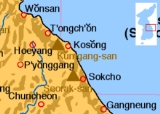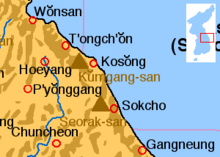
Mt. Soraksan Nature Reserve
Encyclopedia
Seoraksan National Park is a listed by the South Korean government with UNESCO
as a tentative World Heritage site. The Korean government designated the area as a nature reserve in 1965 and UNESCO designated the area as a biosphere reserve in 1982. It was also the first Korean national park to be designated under the National Park Law in 1970. Located on the east and center of the Korean peninsula, the reserve covers Injegun, Yanyanggun, and Sokchosi. It is one of the most popular attractions for tourists and nature enthusiasts in Korea. The Soraksan Nature Reserve is valuable for its stunning natural beauty and rare flora and fauna.
The nature reserve protects an area of 163.6 square kilometers and contains many notable high peaks measuring over 1,200 meters above sea level including the highest peak of Soraksan, Daecheongbong, which has an altitude of 1,708 meters. The nature reserve contains mountain ranges of dissected granite and gneiss and is characterized by spectacular rocky hills and ridges. The magnificent natural beauty of Soraksan and the mountain ridges is due to these geographical features. Annual precipitation in Inner Soraksan is 1000 millimeters and 1300 millimeters in Outer Soraksan.
Soraksan Nature Reserve region is known for the diversity of its flora. There are more than 822 vascular plant species classified in the region and a total of 1,013 species of plants. Pine trees are abundant on the southern slope while the northern slopes of the mountain range are characterized by Oak trees and other deciduous
trees. Other trees include the Thuja
trees which grow in the deep valleys and Siberian pine and native Korean Hanabusaya
trees which grow on the ridges and high altitudes. Dwarf pines, forsythia, saussurea
, and yew trees grow from the foot of the mountain and up. Juniper, hawthorn, and Korean edelweiss
also grow in the reserve. Rare plants protected in the reserve include the Hanabusaya Asiatic and Abios nephrolepis
.
 1,562 animal species have been classified so far. Some notable animals include Asiatic black bears, musk deers, gorals, otters, Pteromys volans, Falco tinnuculus, Chinese sparrow hawks, Brachymystax lenoks, and Hemibarbus mylodon. In particular, endangered species such as the Dryocopos javensis richardsi, Naemorheudus goral raddeanus, and Moschus moschiferus parvipes are considered to be of major conservation significance. In addition to the plants and animals, biologically important and rare fish such as Brachmystax lenok and Moroco oxycephalus which are also protected and preserved.
1,562 animal species have been classified so far. Some notable animals include Asiatic black bears, musk deers, gorals, otters, Pteromys volans, Falco tinnuculus, Chinese sparrow hawks, Brachymystax lenoks, and Hemibarbus mylodon. In particular, endangered species such as the Dryocopos javensis richardsi, Naemorheudus goral raddeanus, and Moschus moschiferus parvipes are considered to be of major conservation significance. In addition to the plants and animals, biologically important and rare fish such as Brachmystax lenok and Moroco oxycephalus which are also protected and preserved.
The reserve is famous not only for its beautiful landscapes but for valuable cultural properties as well including Baekdamsa
and Sinheungsa
, Buddhist temples in the reserve.
SorakSan snows every year when its in the winter, tempature goes under -30, which is very cold.
UNESCO
The United Nations Educational, Scientific and Cultural Organization is a specialized agency of the United Nations...
as a tentative World Heritage site. The Korean government designated the area as a nature reserve in 1965 and UNESCO designated the area as a biosphere reserve in 1982. It was also the first Korean national park to be designated under the National Park Law in 1970. Located on the east and center of the Korean peninsula, the reserve covers Injegun, Yanyanggun, and Sokchosi. It is one of the most popular attractions for tourists and nature enthusiasts in Korea. The Soraksan Nature Reserve is valuable for its stunning natural beauty and rare flora and fauna.
The nature reserve protects an area of 163.6 square kilometers and contains many notable high peaks measuring over 1,200 meters above sea level including the highest peak of Soraksan, Daecheongbong, which has an altitude of 1,708 meters. The nature reserve contains mountain ranges of dissected granite and gneiss and is characterized by spectacular rocky hills and ridges. The magnificent natural beauty of Soraksan and the mountain ridges is due to these geographical features. Annual precipitation in Inner Soraksan is 1000 millimeters and 1300 millimeters in Outer Soraksan.
Soraksan Nature Reserve region is known for the diversity of its flora. There are more than 822 vascular plant species classified in the region and a total of 1,013 species of plants. Pine trees are abundant on the southern slope while the northern slopes of the mountain range are characterized by Oak trees and other deciduous
Deciduous
Deciduous means "falling off at maturity" or "tending to fall off", and is typically used in reference to trees or shrubs that lose their leaves seasonally, and to the shedding of other plant structures such as petals after flowering or fruit when ripe...
trees. Other trees include the Thuja
Thuja
Thuja is a genus of coniferous trees in the Cupressaceae . There are five species in the genus, two native to North America and three native to eastern Asia...
trees which grow in the deep valleys and Siberian pine and native Korean Hanabusaya
Campanulaceae
The family Campanulaceae , of the order Asterales, contains about 2000 species in 70 genera of herbaceous plants, shrubs, and rarely small trees, often with milky non-toxic sap...
trees which grow on the ridges and high altitudes. Dwarf pines, forsythia, saussurea
Saussurea
Saussurea is a genus of about 300 species of flowering plants in the family Asteraceae, native to cool temperate and arctic regions of Asia, Europe, and North America, with the highest diversity in alpine habitats in the Himalaya and central Asia...
, and yew trees grow from the foot of the mountain and up. Juniper, hawthorn, and Korean edelweiss
Edelweiss
Edelweiss , Leontopodium alpinum, is a well-known European mountain flower, belonging to the sunflower family.-Names:The common name comes from German edel, meaning "noble", and weiß "white", thus signifying "noble whiteness".The scientific name Leontopodium is a Latin adaptation of Greek...
also grow in the reserve. Rare plants protected in the reserve include the Hanabusaya Asiatic and Abios nephrolepis
Nephrolepis
Nephrolepis is a genus of about 30 species of ferns in the family Nephrolepidaceae or Lomariopsidaceae .-Selected species:* Nephrolepis biserrata Schott. Nephrolepis is a genus of about 30 species of ferns in the family Nephrolepidaceae or Lomariopsidaceae (included in Davalliaceae in some...
.

The reserve is famous not only for its beautiful landscapes but for valuable cultural properties as well including Baekdamsa
Baekdamsa
Baekdamsa is a Buddhist temple in Inje County, Gangwon province, South Korea. It was originally built in the 7th century, but because of war and natural disasters has been rebuilt numerous times since then. The present version was completed in 1957. Additionally, the name has also changed over...
and Sinheungsa
Sinheungsa
Sinheungsa, sometimes spelled Shinheungsa, is a head temple of the Jogye Order of Korean Buddhism. It is situated on the slopes of Seoraksan in Sokcho, Gangwon Province, South Korea....
, Buddhist temples in the reserve.
SorakSan snows every year when its in the winter, tempature goes under -30, which is very cold.

